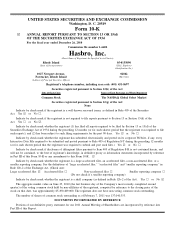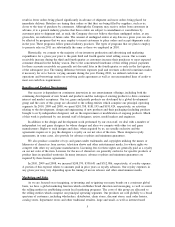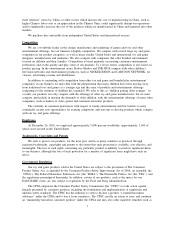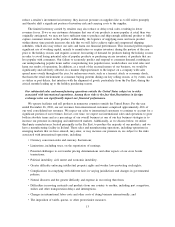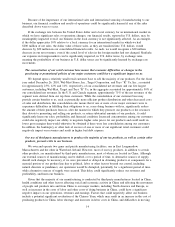Hasbro 2010 Annual Report Download - page 19
Download and view the complete annual report
Please find page 19 of the 2010 Hasbro annual report below. You can navigate through the pages in the report by either clicking on the pages listed below, or by using the keyword search tool below to find specific information within the annual report.The volatility of ever-evolving consumer preferences, combined with the high level of competition and
low barriers to entry in the family entertainment industry, make it difficult to achieve, maintain or build
upon the success of our brands, products and product lines, or introduce successful new brands and
products. In addition, an inability to develop and introduce planned new brands, products and product
lines in a timely and cost-effective manner may damage our business.
The children’s and family entertainment business is a trend-driven industry where consumer demands and
interests evolve quickly. We may develop products which consumers do not find interesting enough to buy in
significant quantities to be profitable to us. Similarly, brands or products that were successful at one time may
lose consumer interest. Our ongoing success is critically dependent upon developing and maintaining the
consumer appeal of our brands and products and in our ongoing ability to achieve and maintain market interest
in and acceptance of our offerings to a degree that enables those brands and products to be profitable. Our
failure to successfully anticipate, identify and react to children’s interests and the current preferences in family
entertainment could significantly lower sales of our products and harm our business and profitability.
A decline in the popularity of our existing brands, products and product lines, or the failure of our new
brands, products and product lines to achieve and sustain sufficient interest from retailers and consumers,
could significantly lower our revenues and operating margins, which would in turn harm our profitability,
business and financial condition. In our industry, it is critical to identify and offer what are considered to be
the next “hot” toys, games and other entertainment offerings on children’s “wish lists” and to effectively
anticipate children’s evolving entertainment interests. Our continued success will depend on our ability to
develop, market and sell popular toys, games and other entertainment offerings, and license our brands for
products which are sought after by both children and their parents, in spite of rapidly evolving consumer
tastes. We seek to achieve and maintain market popularity for our brands and products through the continued
re-imagination, re-invention, re-ignition and extension of our existing family entertainment properties in ways
we believe will capture evolving consumer interest and imagination, offer immersive brand experiences and
remain relevant in today’s world, and by developing, introducing and gaining customer interest for new family
entertainment products. This process involves anticipating and extending successful play patterns, offering
continual product innovation and identifying and developing entertainment concepts and properties that appeal
to children’s imaginations and feed the human need for play. However, consumer preferences with respect to
family entertainment are continuously changing and are difficult to anticipate and we may not successfully
identify product offerings which are sought after by consumers. Evolving consumer tastes, coupled with an
ever changing pipeline of entertainment properties and products which compete for consumer interest and
acceptance, create an environment in which some products can fail to achieve consumer acceptance, and other
products can be extremely popular during a certain period in time but then rapidly be replaced in consumers’
minds with other properties. As a result, individual family entertainment products and properties often have
short consumer life cycles.
Not only must we address rapidly changing consumer tastes and interests but we face competitors who
are also constantly monitoring and attempting to anticipate consumer tastes, seeking ideas which will appeal to
consumers and introducing new products that compete with our products for consumer purchasing. In addition
to existing competitors, the barriers to entry for new participants in the family entertainment industry are low.
New participants with a popular product idea or entertainment property can gain access to consumers and
become a significant source of competition for our products in a very short period of time. In some cases our
competitors’ products may achieve greater market acceptance than our products and potentially reduce demand
for our products and lower our profitability.
The challenge of continuously developing and offering products that are sought after by children is
compounded by the trend of children “getting older younger”. By this we mean that children are expanding
their interests beyond traditional toys and games to a wider array of entertainment products at younger ages
and, as a result, at younger and younger ages, our products compete with the offerings of video game
suppliers, consumer electronics companies, media and social media companies and other businesses outside of
the traditional toy and game industry.
9


